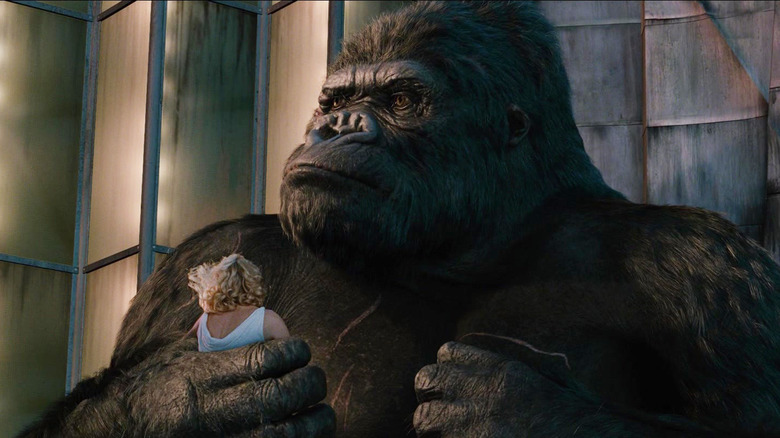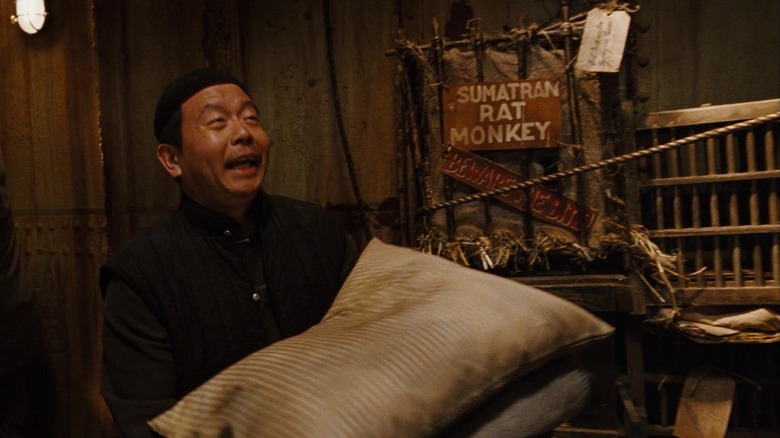Director Peter Jackson Hid An Easter Egg From His Best Horror Movie In King Kong
Following the success of his "Lord of the Rings" movie trilogy adaptation, director Peter Jackson was Hollywood's shiniest golden boy in the early 2000s. He had made millions upon millions of dollars, jumpstarted the New Zealand tourism industry (where the "Rings" films were shot), revolutionized special effects, and racked up 17 Oscars (collectively). He could seemingly do no wrong. So, as a follow-up, Jackson was pretty much allowed to make whatever he wanted and at whatever budget he desired. His dream project, as it turned out, was to remake Merian C. Cooper and Ernest B. Schoedsack's 1933 classic "King Kong." Only this time, Jackson would indulge in every stray impulse and allow his movie to take every possible aside.
Jackson's "King Kong" ended up costing about $207 million and ran a whopping 187 minutes (whereas the original film was only 100 minutes long). It took a very long time for the main characters to arrive on Kong's Skull Island, as Jackson felt that the ape needed a lot more buildup. Meanwhile, King Kong himself was a CGI creation realized via motion-capture. Actor Andy Serkis, who played the computer-animated Gollum via mo-cap in Jackson's "Lord of the Rings" movies, provided Kong's movements, with Naomi Watts playing Ann Darrow and Jack Black portraying Carl Denham (the characters played by Fay Wray and Robert Armstrong in the original 1933 film).
Many critics of Jackson's "King Kong" usually point to its prodigious length as its greatest weakness, as well as the fact that such a large portion of the movie takes place on the boat on the way to Skull Island. 187 minutes is, uh, quite a lot for a "King Kong" film.
But sharp-eyed horror fans will spot something of note on that boat. As the camera takes in the ship's hold at one point, examine the various crates and barrels in storage and one might notice a cage emblazoned with the phrase "SUMATRAN RAT MONKEY" (see the image below). Fans of Jackson's controversial 1992 zombie horror movie "Braindead" (which is known as "Dead Alive" in North America) will be aware that a Sumatran rat monkey played a key role in that film's mayhem.
King Kong has a reference to the Sumatran rat monkey from Dead Alive
The beginning of "Braindead" takes place, yes, on Skull Island (Jackson was already borrowing stuff from "King Kong" at that stage in his career). There, a New Zealand zoo official (Bill Ralston) is attempting to smuggle a Sumatran rat monkey in a cage. (I guess Skull Island is near Sumatra.) The audience can't see it yet, but the animal is said to be the result of rats and monkeys cross-breeding (!). Hence, when the monkey bites the zoo official, his aides panic and kill him with a machete. It's clearly dangerous.
Somehow, the rat monkey then makes its way to a New Zealand zoo, where it is brought to life via stop-motion. It's a gross, strange critter that winds up biting Vera (Elizabeth Moody), the mother of the film's protagonist, Lionel (Timothy Balme). The rat monkey is killed after the biting incident, but Vera soon begins to decay both physically and mentally, becoming a zombie. The rest of "Braindead" is the funniest, goriest movie you'll ever see and contains some of the sloppiest zombie glop in cinema history. (And to think, it was all because of the Sumatran rat monkey.) Indeed, certain horror fans miss those days when Jackson was still immature enough to be utterly disgusting. Such gorehounds lament the success of "Lord of the Rings" for that reason, feeling it took the guts-flinging Jackson away from us.
The bizarre-looking rat monkey didn't appear on-screen in "King Kong," but it would've looked out-of-place if it did. Jackson was well beyond filming stop-motion creatures by 2005, having moved into cutting-edge CGI from New Zealand's Weta Workshop. The phrase "Sumatran rat monkey" was only a label on a cage in "King Kong," but "Braindead" fans knew what that meant, and they were pleased.
Sadly, Peter Jackson's documentary "The Beatles: Get Back" didn't include a similar appearance by, say, the Feebles from his twisted pre-"Lord of the Rings" satire "Meet the Feebles." The only thing that would've improved all that cleaned-up documentary footage of the Beatles was a scene of a vomiting rabbit puppet.

